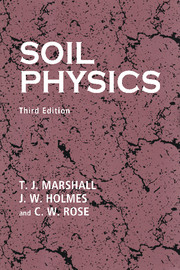Book contents
- Frontmatter
- Contents
- Preface
- Preface to the second edition
- Preface to the first edition
- 1 Composition of soil
- 2 Interaction of soil and water
- 3 Measurement of water content and potential
- 4 Principles of water movement in soil
- 5 Distribution of water in soil
- 6 Ground water in soils and aquifers
- 7 The use of isotopes and other tracers in soil water and groundwater studies
- 8 Soil structure
- 9 Deformation of soil
- 10 Management of soil water
- 11 Soil erosion and conservation
- 12 Chemical transport in soil
- 13 The physical environment of roots
- 14 Plants and soil water
- Appendixes
- References
- Index
12 - Chemical transport in soil
Published online by Cambridge University Press: 05 June 2012
- Frontmatter
- Contents
- Preface
- Preface to the second edition
- Preface to the first edition
- 1 Composition of soil
- 2 Interaction of soil and water
- 3 Measurement of water content and potential
- 4 Principles of water movement in soil
- 5 Distribution of water in soil
- 6 Ground water in soils and aquifers
- 7 The use of isotopes and other tracers in soil water and groundwater studies
- 8 Soil structure
- 9 Deformation of soil
- 10 Management of soil water
- 11 Soil erosion and conservation
- 12 Chemical transport in soil
- 13 The physical environment of roots
- 14 Plants and soil water
- Appendixes
- References
- Index
Summary
Concern for the quality of water has increased a great deal in the last several decades, both in the developed and in the developing world. Deteriorating water quality has been prejudicial not only to human health, but also to the conservation of healthy natural ecosystems; these two aspects are rather intimately related in some regions. Since much of the fresh water on land flows over or through the soil, in which it has a wide range of residence times, soil must play a key role in determining its quality. In this chapter, we provide some of the basic physical knowledge needed to understand the role of soil in affecting water quality. In addition to the naturally occurring soil salts, consideration is also given to contaminant chemicals that are products of industry and society.
Soil characteristics are directly involved in the fate of widespread or nonpoint sources of pollutants. Furthermore, the soil is often used as the site of disposal of the waste products of industry and society, which can accumulate to thick deposits, as in landfills. Surface waters, such as streams, lakes, and reservoirs, tend to receive contaminants from water flow over soil or from eroded soil itself. Leaching through the soil profile tends to be the major path for chemicals that pollute groundwaters. In the longer term, polluted groundwater can also affect surface water quality.
Soil chemicals vary greatly in characteristics which affect their transport. Adsorption of a chemical to the soil constituents, either the mineral or the organic matter, tends to make erosive transport the mechanism of major importance.
- Type
- Chapter
- Information
- Soil Physics , pp. 321 - 357Publisher: Cambridge University PressPrint publication year: 1996



